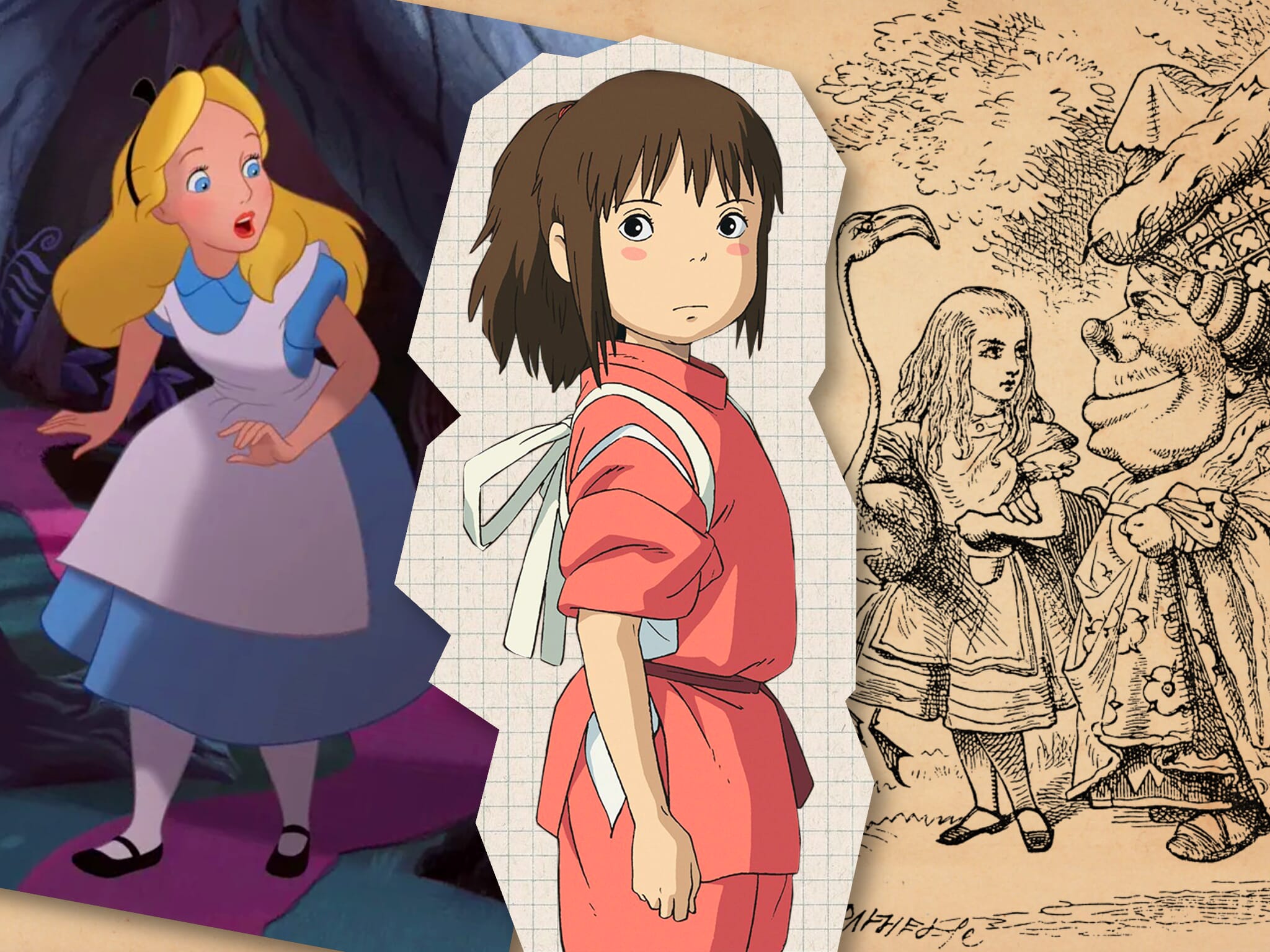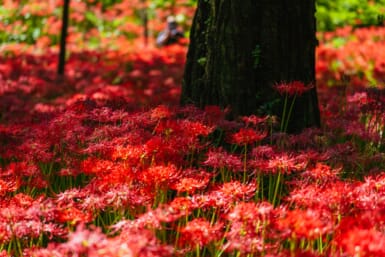Fantasy stories are created from reinvention. When Walt Disney Animation Studios set out on its endeavor to create the first full-length animated feature film, it decided to retell the classic story of Snow White. The fairy tale of Snow White, first published in 1812 in a collection of the Brothers Grimm stories, is actually quite dark and ominous. But with the mass appeal and familiarity of the tale, Disney proceeded with its plan and made several changes to better match its style.
Many were skeptical at first, but when Snow White and the Seven Dwarfs premiered in 1937, the film captured the hearts of millions of people worldwide and remained the highest-grossing animated film for 55 years. Disney Animation continued this pattern of success, retelling other classic fairy tales like Cinderella, Sleeping Beauty and Peter Pan. As the animation industry grew around the world, other studios followed suit, bringing to life folktales and literary heroes that were previously stuck inside pages.
The beauty of classic fairy tales is that they are so timeless, yet they’re constantly being retold with new ideas and variations. Authors and filmmakers get inspired by their favorite characters and stories, and their creations are reflective of all those previous experiences.
In an interview with the Academy of Motion Picture Arts and Sciences, legendary Studio Ghibli director Hayao Miyazaki explained that he was a physically weak child who did a lot of imagining and read many books in which he could picture becoming a strong hero. Years later, he and his team instinctively pulled from childhood memories and characters that truly made an impression on them.
Here are some parallels between classic fairy tales and Studio Ghibli films that will give you a whole new perspective on those stories.
Spirited Away and Alice in Wonderland
Chihiro’s journey in Spirited Away is very reminiscent of the adventures of other young girls traveling through bizarre lands, such as Alice from Lewis Carroll’s Alice in Wonderland and Dorothy from L. Frank Baum’s The Wonderful Wizard of Oz. When Hayao Miyazaki compiled 50 of his favorite children’s books, Alice in Wonderland was among them.
Though Spirited Away has a different plot and aesthetic, its central themes and messages are very similar. Like Alice and Dorothy at the start of their stories, Chihiro is an innocent young girl. She loses her way and is transported into the wondrous world of the spirits when her parents accidentally eat the spirits’ food and turn into massive pigs. Though it’s her first time being all alone, it’s up to her to save her parents and find her way out.
The Japanese title of Spirited Away is Sen to Chihiro no Kamikakushi. In Japanese folklore, a kamikakushi refers to a sudden disappearance or being taken away by spirits, much like how Alice follows the White Rabbit and falls into Wonderland.
As she explores the supernatural entities of the realm, Chihiro meets all kinds of mystifying spirits and creatures that look like animals. She befriends Haku, a boy who can shapeshift into a dragon. He assists her in her quest to return home. Along the way, Chihiro meets a wide cast of interesting characters, such as Kamaji, the spider-like man who operates the bathhouse boiler room. He resembles the caterpillar from Alice in Wonderland. There’s also Boh, the big and spoiled baby who resembles the twins, Tweedledee and Tweedledum.
Of course, there is a clear comparison between Yubaba, the controlling and overbearing proprietor of the bathhouse, and the tyrannical Queen of Hearts. Yubaba rips away Chihiro’s name and plans to have her work in the bathhouse forever when she eventually forgets her own identity. However, using her newfound bravery and friends, Chihiro is able to find freedom and escape back to the human world.
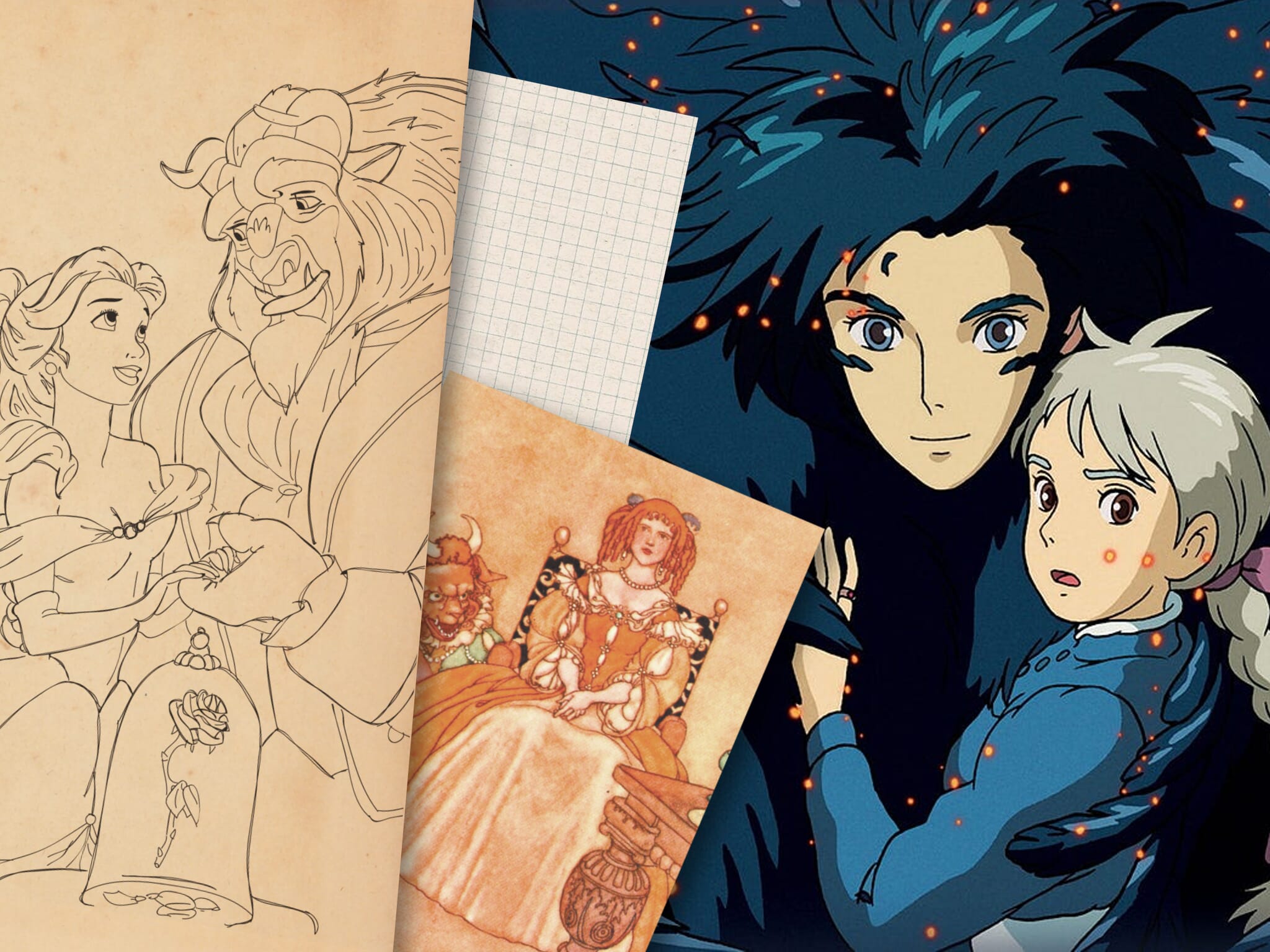
Howl’s Moving Castle and Beauty and the Beast
Howl’s Moving Castle is an adaptation of a 1986 British fantasy novel of the same name. Author Diana Wynne Jones actually wrote a total of three books for the series. The other two were Castle in the Air and House of Many Ways. Jones also wrote Earwig and the Witch in 2011, which became Studio Ghibli’s first fully 3DCG animated film released in 2020.
Aside from the extended adventures and characters introduced in the sequels, Ghibli’s Howl’s Moving Castle kept the plot fairly faithful to its source material while adding touches of whimsy. As well as Jones’ novel, it also has an aura reflective of Beauty and the Beast.
The French fairy tale was originally written by Gabrielle-Suzanne Barbot de Villeneuve in 1740 and there have been countless variations of the story produced since then, including Disney’s variation in 1991 and Mamoru Hosoda’s Belle in 2021. However, even Villeneuve was influenced by ancient legends and mythology, such as the Greek stories of Cupid and Psyche. It’s a tale as old as time.
With its themes of enchanted castles, curses and unconditional love overlooking superficial qualities, Ghibli’s Howl’s Moving Castle reinvents Beauty and the Beast by having both “beauty” and “beast” undergo their own growth and transformation.
Sophie Hatter, who works in the family hat shop, is fairly timid and plain at first as she secludes herself into a mundane routine that she believes is all that she’s destined for. After meeting the magical Howl Pendragon, the Witch of the Waste curses Sophie to become a 90-year-old grandmother. That is the spark that forces her to be more proactive and assertive. She subsequently hires herself as the castle’s cleaner.
At the same time, Howl has a beautiful but vain persona that he has built around himself to hide his true feelings. He continually bleaches his hair to achieve a perfect blonde shade and drapes himself in a colorful cape and jewels. He also maintains a suave, mysterious personality.
In the original novel, Howl spends hours in the bathroom getting ready for the day to impress the local girls. It’s revealed in the movie that Howl is suppressing his cursed beastly form: a giant crow-like creature. He separated and gave away his heart because “a heart’s a heavy burden.”
As he falls in love with Sophie, Howl is able to let go of his vanity and fears of vulnerability. Sophie returns to her regular age and Howl regains his heart, and they set off in their new flying castle for their happily ever after.
Another similar parallel that comes to mind is Turnip Head, who, in the finale of the movie, is transformed into Prince Justin after receiving a kiss from Sophie. Like the castle servants in Beauty and the Beast who were turned into enchanted objects, Prince Justin was condemned to live as a scarecrow.
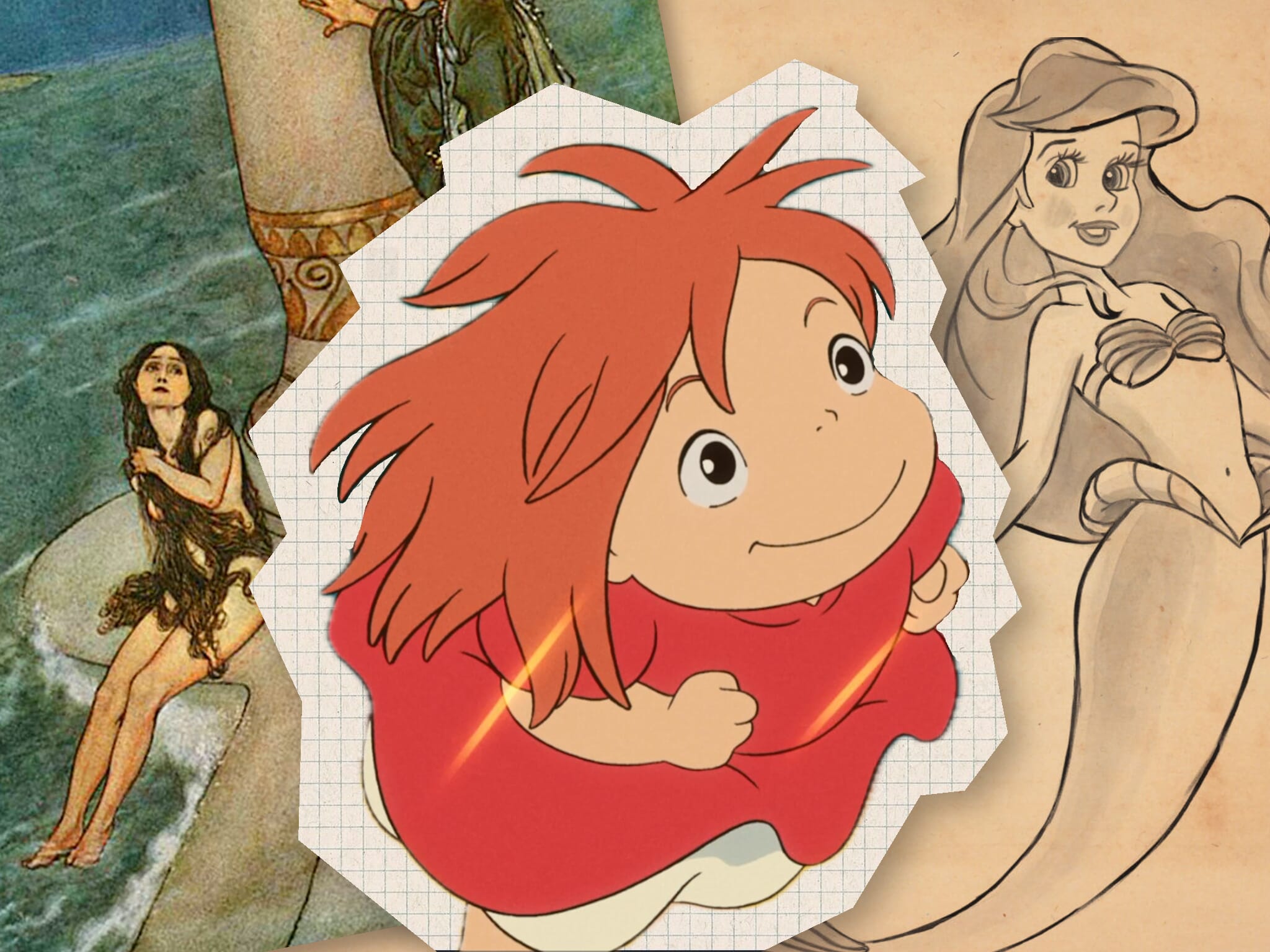
Ponyo and The Little Mermaid
Ponyo has the most direct fairy tale inspiration, as a loose adaptation of Hans Christian Andersen’s 1837 story, The Little Mermaid. Ponyo (birth name Brunhilde) is the energetic goldfish-like daughter of the sorcerer Fujimoto and the ocean goddess Granmamare, who wants to explore the human world above. Just like Andersen’s mermaid and in other popular variations such as Disney’s Princess Ariel, Ponyo wishes to gain independence from her well-meaning, though sometimes controlling father.
She is curious and gets hyper-excited by humans and their creations. When her new human friend Sosuke brings Ponyo to play at home and his mother makes them a bowl of instant ramen, Ponyo is fascinated by the seemingly magical food that comes out of nowhere. She immediately reaches into the hot bowl to get some ham and her eyes widen with happiness, resembling Ariel’s excitement for the human “thingamabobs” in her grotto collection.
Instead of the typical romance plot featured in the other adaptations of The Little Mermaid fairy tale, Ghibli’s Ponyo focuses on platonic and familial love, and gaining autonomy as children develop into adolescence. Ponyo’s character centers on her wonder and curiosity as she learns more about this new world and makes new friends in the community.
Her yearning to come above shore and become a human girl is sparked by her friendship with Sosuke. But also because she wants her own space to grow on her own outside the bubble her father puts her in along with her hundreds of sisters. It’s a classic coming-of-age story that is universally familiar.
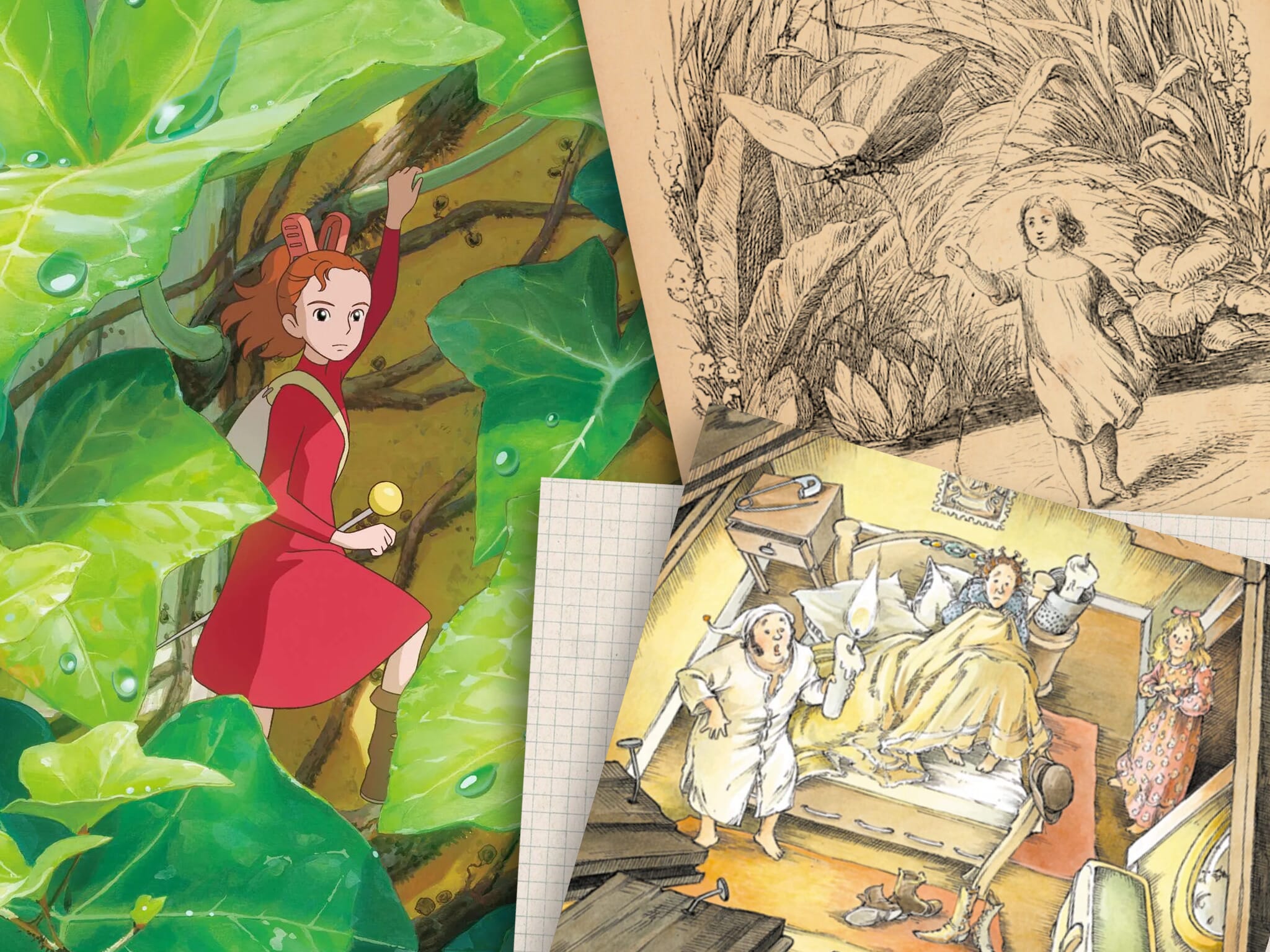
The Secret World of Arrietty and Thumbelina
The Secret World of Arrietty was based on the children’s fantasy book series, The Borrowers, that was written by English author Mary Norton in 1952. In the novels, the tiny Clock family secretly live within the walls of a house, which was based on Norton’s childhood home.
In Studio Ghibli’s version of the story, a young boy named Sho is spending his summer with his mother and great-aunt when he witnesses the tiny Arrietty and her father Pod on a “borrowing” mission to collect tissue paper from his bedside table.
There are many fairy tales and folklore that feature miniature beings and fairies, like Arrietty. Thumbelina is another classic tale by Andersen. Thumbelina is a tiny girl who was born out of the flower of a barley seed when a woman begs a witch for a child. She is so small that she is put to sleep in a walnut-shell crib. When she is taken away by a toad, Thumbelina has to traverse the overwhelming outside world, its elements and its creatures.
Japanese folklore has its own tiny human, Issun-boshi, a “one-inch samurai” who, like Thumbelina, came to be because an old childless couple wished for a baby. According to the fairy tale, Issun-boshi navigates the river using a rice bowl as a boat and chopsticks as oars. When a girl in the capital is kidnapped by an oni demon, Issun-boshi uses a sewing needle as his sword to come to her rescue.
Arrietty, Thumbelina and Issun-boshi demonstrate how, no matter your size or power, you can still overcome great obstacles.
Other Mentions
Along with these examples, there are several other Studio Ghibli films that are direct adaptations of novels and folklore. The Tale of Princess Kaguya is a retelling of a renowned classic Japanese folktale. Like Issun-boshi, Momotaro and Urashima Taro, the story of Princess Kaguya is one that Japanese children very commonly hear in childhood.
Interestingly, a surprising number of these folktales feature babies being born supernaturally from plants or other unusual places. Princess Kaguya was born from a bamboo shoot. Ghibli’s variation is a beautiful animation that communicates themes of immortality and the human experience of life with many joys and sorrows.
Kiki’s Delivery Service, Tales from Earthsea and Nausicaä of the Valley of the Wind are other Ghibli films that were adapted from novels. All have the same English names as their book counterparts except for Tales from Earthsea, which was originally titled A Wizard of Earthsea. Fans can have fun reading the original inspirations for the films to compare their differences and also get an extended view into the worlds of their favorite characters.

